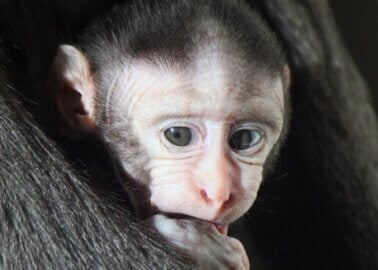Fear Chambers, Drilled Skulls, and Dissection: Over 2.76 Million Procedures on Animals Took Place in British Laboratories in 2022
Implants drilled into monkeys’ skulls, piglets fed Viagra, mice locked in a “fear chamber” …. This distressing list might sound like a line-up of new Black Mirror episodes, but they are all real experiments that sensitive animals endured in British laboratories. And the Home Office has given the green light for all these nightmarish procedures to take place in Britain.
Today, the Home Office revealed that in 2022, more than 2.76 million scientific procedures were carried out on animals in British laboratories – a welcome reduction of almost 10% in comparison to the previous year.

However, millions of additional animals will have also been exploited for breeding and then discarded as “surplus” because they weren’t of the desired sex or lacked certain disease characteristics or for other frivolous reasons, but the government doesn’t consider these animals relevant enough to bother counting.

Poisoning and Electrocuting Animals Is Legal in Britain
In Britain, animals can legally be abused in myriad ways, including being bled, poisoned, and deprived of food, water, or sleep.
They are also subjected to psychological distress and brain damage, deliberately infected with diseases, paralysed, burned, gassed, force-fed toxic substances, electrocuted, and killed.

Here are just five sickening examples of the nightmarish experiments sanctioned by the Home Office:
1. Mice Were Forced Into a ‘Fear Chamber’ for PTSD Studies
The University of Edinburgh conducted experiments on mice in which they trained them in a “fear conditioning chamber” to associate a tone of sound with an electric shock to the foot. This experiment was carried out in a misguided attempt to study human post-traumatic stress disorder. PTSD, as experienced by humans, is impossible to assess in other animals since many of the psychological symptoms, such as flashbacks, emotional numbness, and detachment, are not measurable, and many of the symptoms that experimenters can observe could be attributed to other types of mood disturbances or to species-specific factors that are entirely unrelated to stress or emotion.

2. Part of Rats’ Skulls Were Removed, Then They Were Killed
In a similar study at the University of Bristol, rats underwent craniotomies, where part of their skull was removed to access their brain so that electrodes could be inserted. The animals were then put into a “fear conditioning chamber” where they were trained to associate a tone of sound with an electric shock to the foot. At the end of the experiment, the animals were anaesthetised and killed by circulating chemicals (paraformaldehyde) into the brain so that it could be examined. The experiment was carried out to study how fear is learned and forgotten. But trying to model fear in rodents often fails to translate to effective new treatments for humans.

3. Piglets Were Given Viagra
Also at the University of Bristol, sildenafil, which is sold under the brand name Viagra, was given to piglets to examine the effect on their hearts. The experimenters were simply interested in investigating the effect of the drug under different surgical conditions, even though there is already a well-developed surgical practice in children for whom the drug may be used.

4. Electrodes Were Implanted Into the Skulls and Necks of Mice
At Imperial College London, screw electrodes were implanted into the skull and wire electrodes into the neck muscles of mice to study their sleep. Throughout the experiments, their body temperature was monitored constantly by rectal probe. Afterwards, they were killed and dissected to study their brains.

5. Implants Were Drilled Into Monkeys’ Skulls
Monkeys at the University of Oxford endured surgery in which implants were drilled into their skulls that could prevent them from moving their head when locked into a restraint chair and placed in front of a computer screen. They could only use their hands to respond to stimuli on the screen, for which they received a reward of blackcurrant juice via a tube positioned between their lips – their usual supply of drinking water having been removed for up to 16 hours prior to testing. The curiosity-driven study was carried out to assess how monkeys engage in and make decisions about exploratory behaviour.

Cures for Human Diseases Delayed
Not only do tests on animals cause horrific suffering, even the medicines regulator recognises that they can also filter out potentially effective new drugs, delaying much-needed treatments and cures for human diseases.
PETA is calling on the government to align itself with public opinion by replacing animal testing with modern, humane, and human-relevant research methods. Just last week, the Animals in Science Committee published a letter to ministers calling for a government-led strategy on the uptake and further development of non-animal methods.
There Are Better Ways
PETA’s Research Modernisation Deal lays out a strategy for making the transition to animal-free research. The government must move with the times and end archaic experiments on animals.
Arming future scientists with sophisticated, humane research tools is the best way to safeguard the lives of humans and other animals.
If You Find These Experiments Distressing – Take Action!
The government is dragging its heels, but there is an opportunity for animals. Right now, all political parties are writing their manifesto pledges. If you have a UK address, please contact your MP and demand commitment to a strategy to end experiments on animals.



